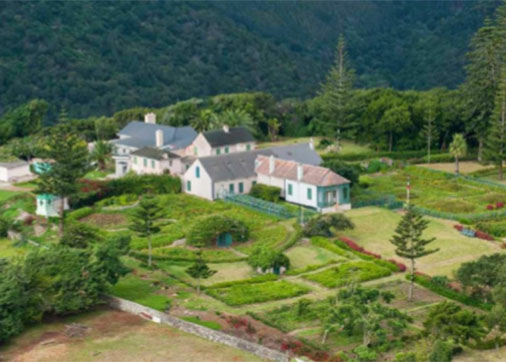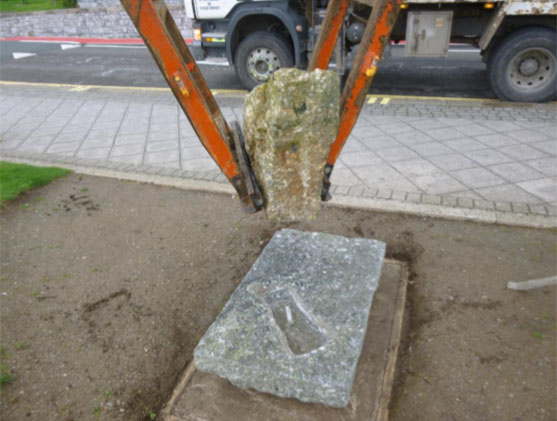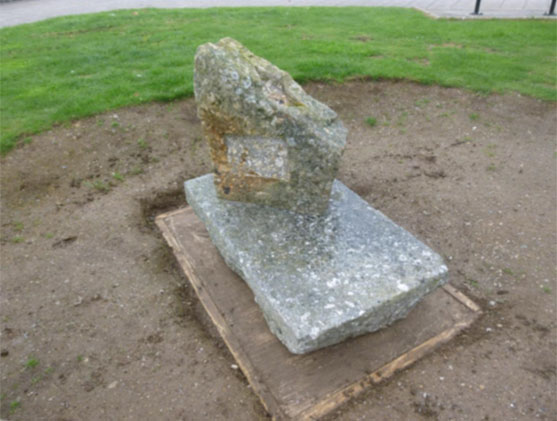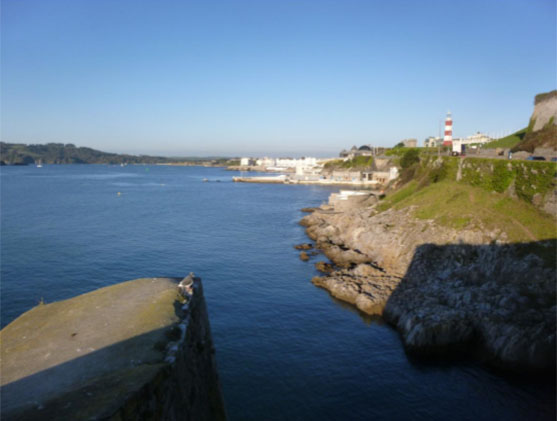Napoleon Commemorative Stone ~ Plymouth Hoe.
Client : The Honorary Consul For France / Plymouth.

If you were asked to think of a name of any famous Frenchman, the name Napoleon would spring to mind more often than not.

Napoleon Bonaparte was born in 1769 in Ajaccio on the French island of Corsica. A military general and 1st Emperor of France, he was one of the most celebrated leaders in the West, he revolutionized military training and organization, re-organized education and helped set up the Napoleonic Code, a set of civil laws which still have importance in a quarter of the worlds jurisdictions. He died on the 5th of May 1821.

At the end of April 2015 we were contacted by Mr. Alain Sibiril, the Honorary Consul for France in Plymouth. He had in mind a project to commemorate a little known event that had took place two hundred years ago in Jennycliff Bay, Plymouth Sound.


The event in question related to the H.M.S Bellerophon where she lay at anchor in Jennycliff Bay for ten days during the summer of 1815. Nicknamed by sailors as the ‘Billy Ruffian’ the 74-gun Bellerophon was built for the British Royal Navy and was launched in 1786. She fought in three fleet actions, the ‘Glorious First of June’, the ‘Battle of the Nile’ and of course the ‘Battle of Trafalgar’.

On board this ship was none other than Napoleon himself. Seeking asylum, Napoleon had surrendered to Captain Frederick Maitland after his defeat at Waterloo bringing an end to the Napoleonic Wars. At that time, the London Times had labelled Napoleon as ‘The Disturber Of The World’. People in the tens of thousands from miles around made their way out to the Bellerophon in Plymouth Sound to catch a glimpse of Napoleon whilst he awaited his fate. Catching a glimpse though proved fatal to one unlucky spectator as he fell into the sea and drowned. His name was ‘John Boynes’ and ironically he was a stonemason who worked at Plymouth Dockyard. You can find his gravestone in Stoke Damerel Parish Church, Devonport.

His epitaph reads…..
‘To the memory of John Boynes, late stone mason of His Majesty’s Dock Yard, who was unfortunately drowned between the Island and Point returning from seeing Bonaparte in the Sound 13th July 1815, aged 35 years.’

In 1805 Great Britain was at war with Napoleon and thousands of French prisoners were confined to prison ‘hulks’ or derelict ships. This was considered to be unsafe as they were too close to Plymouth Dock (Plymouth Naval Dockyard) not to mention the appallingly harsh living conditions encountered upon these prison ships. A prisoner of war depot was planned for and this was agreed to be built in the remote isolation of Dartmoor.

With its imposing entrance H.M. Dartmoor prison is located in Princetown high up on the western edges of Dartmoor. It was designed by British architect and engineer Daniel Asher Alexander and built within a three year time span between 1806 and 1809 by local labour. The initial cost of £130,000 was far exceeded and the contractor went broke. Originally known by the name ‘Dartmoor Depot’, it was designed to hold around 5,000 men. Later, because of overcrowding, two more prison blocks were built and the number of prisoners then rose to around 8,000. The land where the proposed prison was going to be built was owned by the Prince of Wales. Local landowner Sir Thomas Tyrwhitt the founder of Princetown was a close friend and secretary to the Prince and together they realised they could profit from the construction of the prison, the Prince by being paid a rent from the leasehold of his land and Tyrwhitt would supply the granite from his quarries for its construction. The first French prisoners arrived here during May 1809. The prison is one of the oldest prisons in Great Britain that continues to house prisoners to this day and is still owned by the present Prince of Wales and forms part of the Duchy Estates. The Latin inscription ‘PARCERE SVBJECTIS’ which is cut into the granite of the arched entrance translates as…..
‘Spare The Vanquished’

Prior to commencing work we were given an artist’s impression of the commemorative stone which Alain Sibiril had in mind.

In one corner of the prison farm lies a pile of Dartmoor granite blocks of all shapes and sizes. These stones were probably surplus to requirements from the original construction of the prison itself. The ‘Duchy Estates’ had given permission to take whatever granite was needed to use for the commemorative stone to mark the occasion of Napoleon being held captive in Plymouth Sound.

Two blocks of Dartmoor granite were chosen for the task, one was approximately 1300mm long, 900mm wide and 250mm thick and would form the base. This was silver grey in colour.

The other piece of granite was an angular shaped block, pink in colour and about 700mm high, 450mm wide and approximately 500mm long.

The angular block was going to be set upright on the base and due to its shape it was going to represent the sail of a ship. A recess was going to be cut into one of the sides to receive a bronze plaque crediting who was involved in the project and another bronze plaque was going to be set into the base stone telling the story of Napoleon aboard the Bellerophon in Plymouth Sound.

St. Helena is a tropical island of volcanic origin in the South Atlantic Ocean and is one of the oldest of the fourteen British Oversea Territories. It’s also one of the most remotest islands on Earth. It was here in 1815 that the British government chose to send Napoleon as his place of exile. First staying at Briars Pavilion until his permanent residence Longwood House was built, Napoleon stayed here until his death in 1821. In 1858 the French Government negotiated with the British to transfer Longwood House over to the French Foreign Ministry where it has been under their control ever since.



Longwood House today is a museum and its present curator and French Consul is Michel Martineau. Alain Sibiril the Honorary French Consul in Plymouth contacted his counterpart at Longwood House and asked if it was possible for them to donate a piece of stone that was used in the construction of Longwood house. During April 2014 Michel Martineau handed over a piece of stone to Captain Francois-Xavier Polderman captain of the French naval ship ‘F.N. Mistral’ to start its 4600 mile journey from St. Helena to Plymouth in the UK. This little piece of stone actually came from the room where Napoleon was said to keep his personal belongings.

Stone from St. Helena is volcanic ‘Tuff’, it’s brownish red in colour and known locally on the Island of St. Helena as ‘Red-stone’. Its colour is due to having a high concentration of manganese oxide. Tuff is made from the ash ejected from a vent during a volcanic eruption. Following its ejection and settlement this ash overtime becomes compacted into solid rock during a process called consolidation. Tuff is also known as ‘Tufa’ especially when used as a construction material. It’s a fairly soft stone and has been used for construction since ancient times. The word tufa is Italian in origin and this stone was used extensively by the Romans. The Rapa Nui people also used Tuff to construct the famous Moai statues situated on Easter Island, and the small piece of volcanic stone donated from St. Helena was going to be embedded into the granite on top of the commemoration stone.

Once we arrived at the prison farm the first thing we did was set up a lifting gantry to lift the heavy ‘sail’ stone into its position.


Once positioned in the correct place we marked out the base and cut out a recess to a depth of about four inches. The sail stone was going to be set into this recess and holes were going to be drilled into both bits of granite to receive one inch diameter non ferrous dowels and fixed with anchor resin mortar to ensure it could not topple over when it would eventually be situated on Plymouth Hoe.


To form the recess we used a four inch mini grinder with a diamond cutting blade to cut out the worst and then cleaned it up by hand with the help of tungsten tipped chisels.


When the recess was completed the base of the sail stone was also shaped to fit the recess and then dropped into position to see if everything lined up as it needed to do.

The next job was to cut out an area on the side of the sail stone to which the bronze crediting plaque was going to be fitted. This had to be cut back to form a flat surface and to the exact size of a piece of A4 paper.

The second bronze plaque was going to be set on the granite base stone itself in front of the sail stone and this tells you about Napoleon in Plymouth Sound and also the history of the stone used for the project. This plaque was A3 in size.

Finally the top of the sail stone was marked out and another four inch recess was cut out to take the small piece of stone that came all the way from St. Helena.



The red volcanic stone from Longwood House on St. Helena is very soft and the easiest way to shape this to fit into the recess we created was by using a tool aptly named a ‘French drag’. A french drag can come in all manner of shapes and sizes and is basically a serrated tool to plane down the surfaces of soft stone. It’s also known as a ‘Cockscomb’ or a ‘Stonemason’s drag’.


This piece of volcanic stone was also going to be set into position with the aid of dowels and anchor resin. With all the cutting work completed it was now ready for the final leg of its journey from Dartmoor prison to Plymouth Hoe where it would be permanently fixed in place.



A lorry complete with a hydraulic block grab was used to pick up the two blocks of granite from Dartmoor prison.

On Plymouth Hoe a concrete base had been laid to receive the granite blocks.

When the granite arrived a B.B.C. film crew were on site to film it being lifted into position as part of a short film about the project and this was shown on the local T.V. programme ‘Inside Out’.



Once positioned and bedded on to its base it was ready to have the two bronze plaques and the stone from St. Helena fixed into place. The ground levels were also reduced and new turf laid to suit the new level of the commemorative stone.

The site chosen for its location was at the foot of Plymouth’s Royal Citadel overlooking Plymouth Sound where the H.M.S Bellerophon had once laid her anchor with Napoleon onboard.

Plymouth City Council placed an information board on site to explain the history of Napoleon and the project itself.

The two bronze plaques were manufactured by a company called Photocast based in Liverpool.



The two plaques and the stone from St. Helena were fixed into position with dowels and anchor resin.



On the 16th of October 2015 the unveiling ceremony took place on Plymouth Hoe to coincide with the arrival 200 years earlier of Napoleon on the island of St. Helena.


Amongst the guests attending the unveiling were, from left to right, Mrs Kedell Worboys MBE, St Helena Government UK Representative. Dr. John Mahony, Lord Mayor of Plymouth, and Mr. Alain Sibiril, Honorary Consul of France in Plymouth. A few months later H.M.P Dartmoor asked us to produce a scaled down replica of this stone to be housed in the Dartmoor Prison Museum, you can read about this project if you click here.

Napoleon on St. Helena.
(Francois-Joseph Sandmann.)


